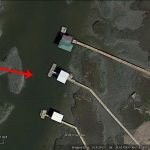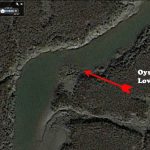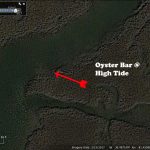How to Fish a Marsh
The marshes around Amelia Island are vast and overwhelming. Blind casting is like trying to drive from Seattle to Amelia Island without a map. You’ll get there but it may be a long trip. So what information do you need to create your own marsh fishing map? To start it helps to understand what fish are looking for. The number one priority after protection from dolphins is food. Food must be obtained expending the least amount of energy. That is where structure comes into the picture. The best place to hide from the current and let dinner swim by is structure.
It is best to explore creeks during low tide to identify locations that may hold fish when water covers the area.
The number one rule to creek fishing is to always cast into the current and retrieve with the current. Bait fish, crabs, and shrimp do not swim against the current so your bait should move the same way.
Choke Points
Chokepoints are areas that are narrower than the surrounding creek. Bait is concentrated by choke points. The narrowing of the creek and a higher current speed also makes the bait more vulnerable. Changing tides force bait through choke points. Game fish may hide behind the structure that blocks the current. Cast upstream and let your bait move with the current to simulate the natural movement of the bait.
Pilings
Any piling provides structure. There is a current break and protection from predators. Barnacles also provide food for sheepshead and the scraps bring in crabs which provide food for redfish and trout. Make sure to bring your bait downstream under and around docks and pilings.
Oyster Bars
Oyster bars provide a break in the current and also food. Baitfish and small crabs hide in oyster bars. Fish will hold on the down current side of an oyster bar waiting for baitfish or crabs to dislodge and come downstream. Cast up current from the oyster bar and bring your bait beside or over the bar. Oyster beds are easy to find during low tide.
If you can find a choke point with an oyster bar so much the better. Fish will be able to hide behind the oyster bar and wait for bait to come by. If there is no oyster bars look for a point for the fish to protect themselves from the current.
Creek Mouths
Creek mouths are like choke points because they channel baitfish into a specific area. Bait is washed into the main body of water and is immediately swept downstream. This action concentrates bait close to the shore of the main body of water downstream from the feeder creek. Normally you should anchor in the main body of water downstream from the creek mouth so you can cast into the feeder creek and retrieve your bait into the main body of water. Another anchor point is a bit further downstream so you can cast into the main body of water in front of the feeder creek.
Deep Holes
Deep holes are another structure that helps to keep fish in a small area. Fish usually hold on the upstream side of a hole. They are waiting for bait to tumble into the hole or to swim over them. The correct position to anchor is downstream from the hole but within casting distance of the upstream edge.
Shorelines
The shoreline is also a good place to find fish. This technique only works at high tide when the water reached the edge of the marsh grass. Fish are looking for crabs that live in the bank or next to the creek edge. It is not necessary to fish with fiddler crabs though. Any bait will attract a bite from an opportunistic feeder. Drifting parallel to the shore and casting to shore is a good system. Or anchoring next to the grass and casting parallel to shore can be very effective.







